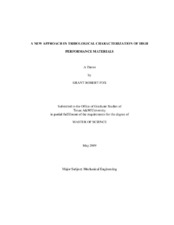| dc.description.abstract | This research conducts tribological investigation in three areas. The first area of research is to obtain basic understanding of tribological properties of high performance Inconel alloys. Pin-on-disk testing was conducted through a range of applied normal loads and sliding velocities in an unlubricated condition. Average friction coefficient, friction work, and specific wear rates were calculated from the data and microscopy techniques were used to observe and characterize wear mechanisms. Experimental results show a dependence of average coefficient of friction as a function of frictional work. Also shown is the wear rate dependence on frictional work, predicated by a wear mechanism change. This research gives a tribological baseline for high performance alloys.
The second area of research is in the in situ spatial study of friction, complemented by monitoring changes in electrical contact resistance (ECR). Pin-on-disk testing of samples was done under low normal loads and velocities. Friction and electrical contact resistance measurements were taken spatially in the wear track during each friction cycle, giving a spatial evolution of friction and resistance change, in situ. Results show a lowering in the ECR under increased friction cycles, which was closely related to a change in the friction coefficient of the material. Using surface profilometry and X-ray Photoelectron Spectroscopy, we determined that the lowering of resistance is a result of surface modification through wear and development of a friction induced conductive tribo-film. This research provides a simple method for in situ monitoring of friction and solidifies a fundamental relationship between friction and contact resistance. The third area of research is the design of a variable force tribometer, incorporating the fundamental results demonstrated in the first two experiments. The creation of a novel testing apparatus to test materials under dynamic tribological conditions is given in detail. Simple experiments were performed on an Inconel sample and preliminary results show how dynamic normal and tangential forces affect the friction coefficient. These early results utilizing the variable force tribometer will lay the groundwork for more advanced research into the dynamic nature of friction. | en |


